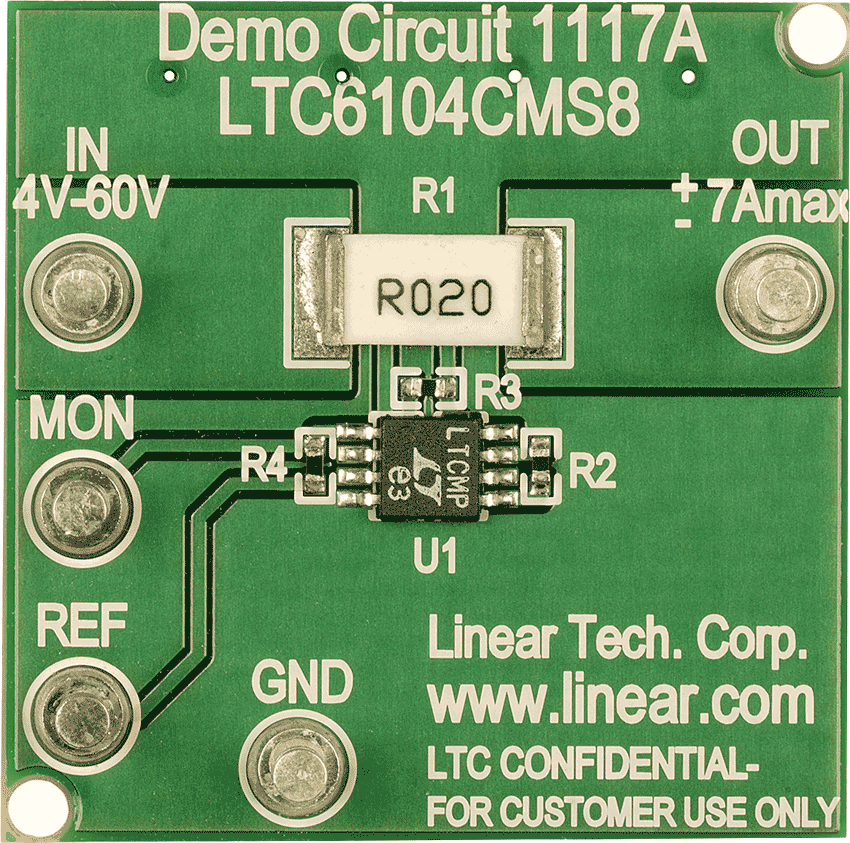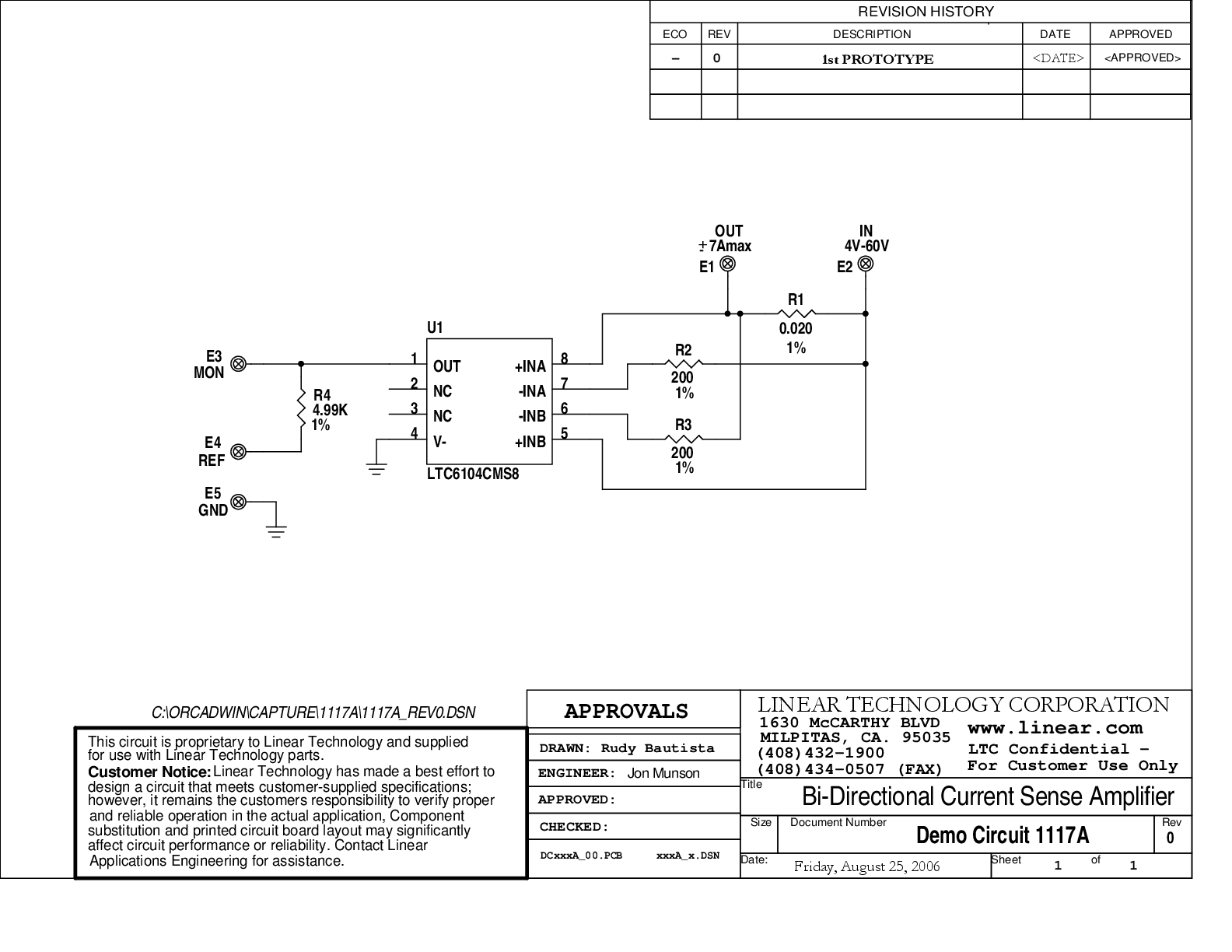Products
LTC6104
RECOMMENDED FOR NEW DESIGNSHigh Voltage, High Side, Bi-Directional Current Sense Amplifier
- Part Models
- 6
- 1ku List Price
- Starting From $1.69
Viewing:
Part Details
- Wide Supply Range: 4V to 60V with 70V Absolute Maximum
- Low Offset Voltage: ±450µV Maximum
- Fast Response: 1µs Response Time
- Gain Configurable with External Resistors; Each Direction is Gain Configurable
- Low Input Bias Current: 170nA Maximum
- PSRR: 110dB Minimum
- Output Current: ±1mA Maximum
- Low Supply Current: 520µA, VS = 12V
- Specified for –40°C to 125°C Temperature Range
- Available in an 8-Lead MSOP Package
The LTC6104 is a versatile, high voltage, high side, bidirectional current sense amplifier. Design flexibility is provided by the excellent device characteristics: ±450µV maximum offset and only 520µA of current consumption (typical at 12V). The LTC6104 operates on supplies from 4V to 60V.
The LTC6104 monitors bi-directional current via the voltage across an external sense resistor (shunt resistor). This sense voltage is then translated into a ground referenced signal. Gain is set with three external resistors and can be separately configured for both directions. Low DC offset allows the use of a small shunt resistor and large gain-setting resistors. As a result, power loss in the shunt is minimal.
The wide operating supply range and high accuracy make the LTC6104 ideal for a wide variety of automotive, industrial and power management applications. A maximum input sense voltage of 500mV allows a wide range of currents to be monitored. The fast response makes the LTC6104 the perfect choice for load current warnings and shutoff protection control. With very low supply current, the LTC6104 is suitable for power sensitive applications.
The LTC6104 is available in an 8-lead MSOP package.
Applications
- Current Shunt Measurement
- Battery Monitoring
- Remote Sensing
- Power Management
Documentation
Data Sheet 1
Reliability Data 1
User Guide 1
Application Note 1
Design Note 1
Technical Articles 1
Video 1
Product Selector Card 1
ADI has always placed the highest emphasis on delivering products that meet the maximum levels of quality and reliability. We achieve this by incorporating quality and reliability checks in every scope of product and process design, and in the manufacturing process as well. "Zero defects" for shipped products is always our goal. View our quality and reliability program and certifications for more information.
| Part Model | Pin/Package Drawing | Documentation | CAD Symbols, Footprints, and 3D Models |
|---|---|---|---|
| LTC6104CMS8#PBF | 8-Lead MSOP | ||
| LTC6104CMS8#TRPBF | 8-Lead MSOP | ||
| LTC6104HMS8#PBF | 8-Lead MSOP | ||
| LTC6104HMS8#TRPBF | 8-Lead MSOP | ||
| LTC6104IMS8#PBF | 8-Lead MSOP | ||
| LTC6104IMS8#TRPBF | 8-Lead MSOP |
| Part Models | Product Lifecycle | PCN |
|---|---|---|
|
Oct 11, 2022 - 22_0244 Epoxy Change from Henkel 8290 to 8290A for MSOP Package |
||
| LTC6104CMS8#PBF | PRODUCTION | |
| LTC6104CMS8#TRPBF | PRODUCTION | |
| LTC6104HMS8#PBF | PRODUCTION | |
| LTC6104HMS8#TRPBF | PRODUCTION | |
| LTC6104IMS8#PBF | PRODUCTION | |
| LTC6104IMS8#TRPBF | PRODUCTION | |
|
Feb 3, 2020 - 20_0128 Laser Top Mark for 8 Lead MSOP Packages Assembled in ADPG and UTAC |
||
| LTC6104CMS8#PBF | PRODUCTION | |
| LTC6104CMS8#TRPBF | PRODUCTION | |
| LTC6104HMS8#PBF | PRODUCTION | |
| LTC6104HMS8#TRPBF | PRODUCTION | |
| LTC6104IMS8#PBF | PRODUCTION | |
| LTC6104IMS8#TRPBF | PRODUCTION | |
This is the most up-to-date revision of the Data Sheet.
Hardware Ecosystem
| Parts | Product Life Cycle | Description |
|---|---|---|
| Current Sense Amplifiers 1 | ||
| LTC4151 | PRODUCTION | High Voltage I2C Current and Voltage Monitor |
Tools & Simulations
LTspice 1
Models for the following parts are available in LTspice:
- LTC6104
LTpowerCAD
Design tools for the following parts are available in LTpowerCAD:
LTspice® is a powerful, fast and free simulation software, schematic capture and waveform viewer with enhancements and models for improving the simulation of analog circuits.
Evaluation Kits
Latest Discussions
No discussions on LTC6104 yet. Have something to say?
Start a Discussion on EngineerZone®




